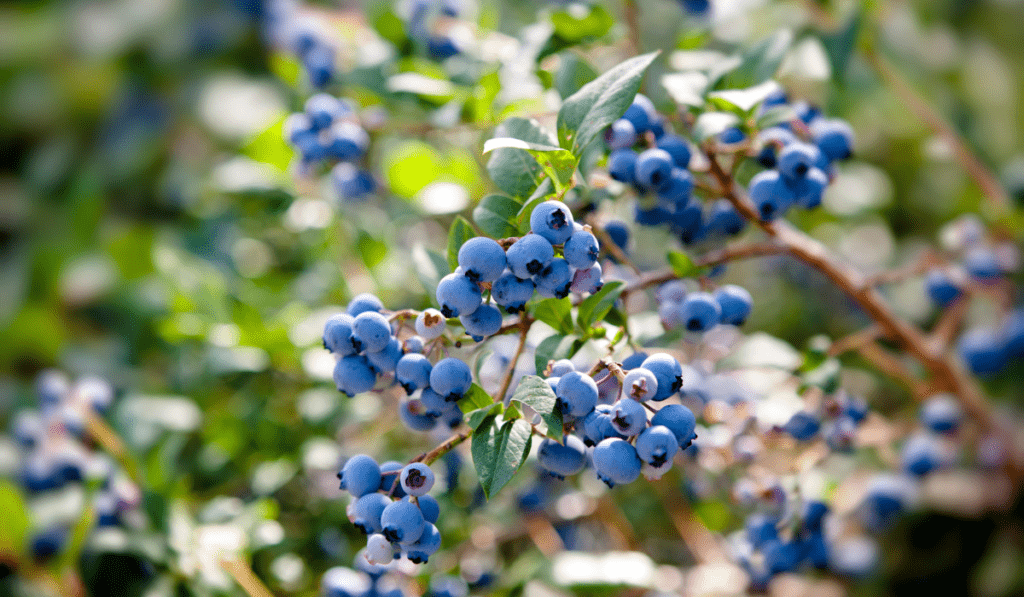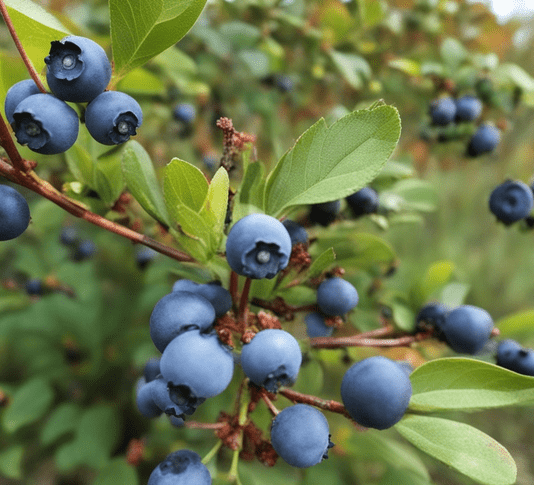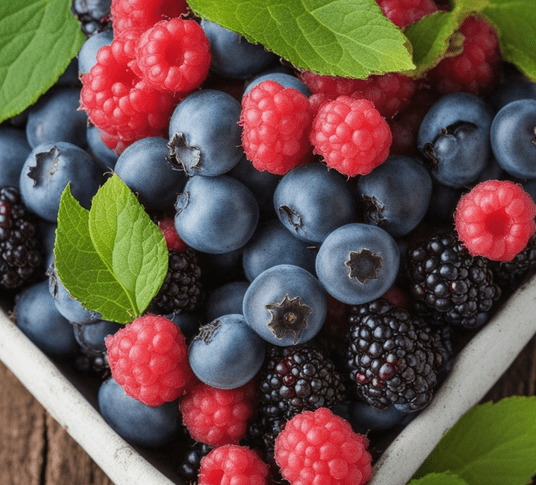Blueberries are popular fruits that offer several health benefits such as reducing the risk of heart disease and cancer, improving brain function, and aiding weight loss.
The rabbiteye blueberry variety is especially desirable due to its hardiness in USDA zones 7 through 9 and later harvesting season than other varieties like highbush blueberries.
Growing your own blueberry bushes not only provides you with access to fresh produce but also helps reduce your carbon footprint by eliminating transportation emissions from store-bought fruit.
This article aims to provide detailed guidelines on planting rabbiteye blueberries in your backyard.
Site Selection and Preparation for Rabbiteye Blueberries
To ensure optimal growth of rabbiteye blueberry plants, it’s essential first to choose the right location for planting them.
- Soil requirements: Blueberry plants grow best in soil with a ph level between 4.5 -5 pH levels; lower pH levels indicate higher acidity which anchor plant roots well making nutrients available essential for their growth.
- Sunlight Exposure: Healthy fruit production requires at least six hours of direct sunlight per day or higher light exposure will yield lots more flavorful berries.
Planting Process for Rabbiteye Blueberries
Choosing quality nursery-purchased healthy seedlings paves way harvesting excellent quality produce required.
- Preparing root balls:
- Loose soil trenches:
Preparing Root Balls
After acquiring quality nursery-purchased healthy seedlings, the next crucial step in planting Rabbiteye Blueberries is preparing their root balls. Properly preparing the root balls sets the stage for optimal growth and ensures the long-term health of your blueberry plants.
- Inspect the Seedlings: Begin by carefully inspecting each seedling. Look for well-developed roots and a healthy, disease-free appearance. Avoid planting any seedlings with signs of damage or stress.
- Gently Loosen the Roots: Carefully loosen the roots of each seedling. This helps prevent the roots from continuing to grow in a circular pattern and encourages them to spread outwards into the surrounding soil. Gently untangle any matted roots, being cautious not to damage them.
- Trimming Long or Damaged Roots: If you encounter particularly long or damaged roots, consider trimming them. Use clean, sharp pruning shears to make clean cuts. This encourages the growth of new, healthy roots and ensures that the plant allocates its energy efficiently.
- Prepare the Planting Hole: Before placing the seedling in the ground, dig a hole that is wide enough to accommodate the roots without bending or crowding. The hole should be slightly shallower than the length of the root ball.
- Positioning the Seedling: Set the seedling in the center of the hole, ensuring that it sits at the same depth as it did in the nursery container. The soil level on the stem should match the surrounding ground level.
- Backfilling with Soil: Gently backfill the hole with soil, firming it around the roots as you go. Take care not to leave air pockets, as these can lead to uneven settling of the soil.
- Watering Thoroughly: Once the seedling is planted, water it thoroughly to help settle the soil and hydrate the roots. Adequate watering is crucial during the initial planting phase to support the establishment of the blueberry plant.
- Mulching Around the Base: Apply a layer of organic mulch around the base of the plant, leaving a few inches of space around the stem. Mulching helps retain soil moisture, suppress weeds, and regulate soil temperature.
Loose Soil Trenches
In addition to preparing the root balls, creating loose soil trenches is a vital aspect of the planting process for Rabbiteye Blueberries. This technique ensures that the surrounding soil provides an optimal environment for root development and overall plant health.
- Understanding Soil Structure: Rabbiteye Blueberries prefer well-draining, acidic soils. Before planting, assess your soil type. If your soil tends to be heavy or compacted, creating loose soil trenches becomes especially crucial.
- Digging the Trenches: Alongside each row of blueberry plants, dig trenches that are approximately 12 to 18 inches deep. The width of the trench can vary but is generally around 12 inches. Ensure that the trenches run parallel to the rows of plants.
- Loosening the Soil: Break up the soil at the bottom of the trench, ensuring that it is loose and friable. This allows the roots to penetrate easily and facilitates the absorption of water and nutrients.
- Incorporating Organic Matter: Enhance the soil in the trenches by incorporating organic matter. Well-rotted compost or peat moss can be mixed into the loosened soil. This improves the soil structure and provides essential nutrients for the blueberry plants.
- Maintaining an Acidic Environment: Rabbiteye Blueberries thrive in acidic soils with a pH between 4.0 and 5.5. If your soil pH is higher, consider adding soil amendments like sulfur to achieve the desired acidity. This can be particularly important for areas with naturally alkaline soils.
- Planting in Rows: As you plant each blueberry seedling, position it within the trench, ensuring that the roots are placed in the loose, amended soil. This encourages the roots to grow outward into the optimal environment you’ve created.
- Backfilling with Soil: After placing the seedlings, gently backfill the trenches with the amended soil. Ensure that the soil is well-packed around the roots to provide stability for the plants.
- Watering and Mulching: Water the newly planted blueberry bushes thoroughly. Mulch the area around each plant to help retain moisture, suppress weeds, and maintain a more consistent soil temperature.
Caring for your Rabbiteye Blueberries Bushes
Once the planting process is done, blueberries require proper care to ensure their optimal growth.
Watering and Mulching
After completing the meticulous process of planting Rabbiteye Blueberries in loose soil trenches, the next critical steps involve proper watering and mulching. These actions are instrumental in providing ongoing care and creating an environment conducive to the optimal growth of your blueberry bushes.
- Watering Guidelines:
- Initial Watering: Immediately after planting, provide a thorough watering to help settle the soil around the roots. Ensure the soil is evenly moist but not waterlogged.
- Establishment Period: During the first few weeks, monitor soil moisture regularly. Water when the top inch of soil feels dry. Blueberry plants benefit from consistent moisture, especially as they establish their root systems.
- Deep Watering: Instead of frequent shallow watering, aim for deep, infrequent watering sessions. This encourages the development of deep, resilient roots. Consider using a soaker hose or drip irrigation to deliver water directly to the soil without wetting the foliage.
- Mulching Practices:
- Mulch Type: Apply a layer of organic mulch around the base of each blueberry plant. Materials like straw, wood chips, or pine bark are excellent choices. Mulching serves multiple purposes, including moisture retention, weed suppression, and temperature regulation.
- Mulch Depth: Spread the mulch to a depth of 2 to 4 inches. Avoid piling it against the trunk of the blueberry bushes to prevent potential issues with rot or pests.
- Mulch Boundary: Extend the mulch in a radius around each plant, covering the entire root zone. This helps maintain a consistent soil temperature and prevents competition from grass or weeds.
- Monitoring and Adjusting:
- Regular Checks: Periodically check the soil moisture beneath the mulch. Adjust your watering frequency based on weather conditions and the specific needs of your blueberry plants.
- Mulch Renewal: Over time, mulch breaks down and decomposes. Renew the mulch layer as needed to maintain its effectiveness. This is typically done annually or as the mulch layer thins.
- Benefits of Proper Watering and Mulching:
- Disease Prevention: Keeping the foliage dry through proper watering practices can contribute to the prevention of diseases, as many fungal issues thrive in damp conditions.
- Root Protection: Mulching helps protect the delicate root system from extreme temperatures, conserving soil moisture and preventing temperature fluctuations.
Pruning techniques
After harvest time pruning removes unwieldy stems stimulate enhanced second-year production capacities stunting disease-free bushels,(within weeks post-flower happening within weeks that follow),sever off ends past most desolate looking buds.Methods include sealing cut surface wounds using equal parts tree wound sealant mixed approximating petroleum jelly also reducing side shoots through recommended spacing standards separate young five vigorous branches remaining.Otherwise marginal sprouts having minimal fruit bearing capability demand eradication creating weaker grows same time.
Protecting Against Common Pests and Diseases
Beyond the initial steps of planting and providing adequate care for your Rabbiteye Blueberries, safeguarding them against common pests and diseases is crucial for ensuring a bountiful harvest. Adopting preventive measures and staying vigilant can mitigate the risks associated with potential threats.
- Identification of Common Pests:
- Blueberry Maggots: Keep an eye out for the small, yellowish maggots that can infest blueberries. Consider using sticky traps to monitor their presence and take appropriate action if detected.
- Aphids and Spider Mites: Regularly inspect the undersides of leaves for aphids or spider mites. These pests can affect the health of the plants by sucking sap from the foliage.
- Japanese Beetles: Monitor for Japanese beetles, which can cause extensive damage to blueberry plants by feeding on the leaves and fruits.
- Preventive Measures:
- Neem Oil Application: Consider applying neem oil as a preventive measure against a variety of pests. Neem oil has insecticidal properties and can help deter pests from infesting the plants.
- Beneficial Insects: Introduce or encourage beneficial insects, such as ladybugs and predatory beetles, that naturally prey on common blueberry pests.
- Companion Planting: Explore companion planting strategies to repel pests. For instance, planting aromatic herbs like basil or marigolds near blueberries can deter certain pests.
- Disease Prevention Strategies:
- Pruning Practices: Adopt proper pruning techniques to ensure good air circulation, as improved airflow can reduce the risk of fungal diseases.
- Fungicide Applications: In areas prone to fungal diseases, consider applying fungicides preventively, especially during the growing season. Copper-based fungicides are commonly used for blueberries.
- Regular Inspections: Routinely inspect your blueberry plants for any signs of diseases, such as leaf spots or wilting. Early detection allows for prompt intervention.
- Integrated Pest Management (IPM):
- Implementing IPM: Adopt an Integrated Pest Management approach, combining cultural, biological, and chemical control methods. This holistic strategy aims to manage pests in an environmentally responsible manner.
- Monitoring and Record-Keeping: Keep records of pest and disease occurrences, monitoring trends over time. This information can guide future prevention and intervention strategies.
- Consulting Local Extension Services:
- Local Expertise: Reach out to local agricultural extension services or experienced gardeners in your region. They can provide valuable insights into prevalent pests and diseases in your area and recommend suitable preventive measures.
Harvest Time for Rabbiteye Blueberries
A.) Figuring Out When It Is Time To Harvest:
Harvest time for Rabbieye Blueberry Bushes comes between mid-June through early August harvest ripened cherries when color deepens intensity reveals increased sugar content.This can easily be determined by checking if berries slide off easily from stems indicating readiness.Write down harvest days note observation asked fellow growers how well doing tell maturity based upon brand should match up factor-in climatic conditions reached full fertility lifespan available.
B.)Best ways How Users Can Pick Their Fruit Safely Without Causing Damage
Taking necessary precautions taking hay bales positioned opposite each other woven cloth-basket becoming perfect pickers slip into empty baskets,kneeling adjacent enough comfortably reaching loads emptying daily producing methods plastic pickle buckets additions that can be checked for dryness, moisture. Immediately harvest refrigerate store fruits up-to a week then enjoy fresh or dried as preserved solid snacks
Conclusion
Overall, planting rabbiteye blueberry bushes is relatively easy with proper planning and implementation.Careful nurturing techniques are what farmers cite in establishing successful crops so growers must look to tackle complex challenges facing from healthy soil conditions through pest controlling/maintenance cultivation agendas diseases outlasting organisms thrive farm-harvesting plants yielding quality products.Feedback should always serve necessary updates on how each nifty step encountered could improve respected crop growths.Don’t get discouraged by the learning curve this article aims at inspiring a new generation of gardeners willing to embrace innovative approaches towards zero-waste practices? Happy farming!



